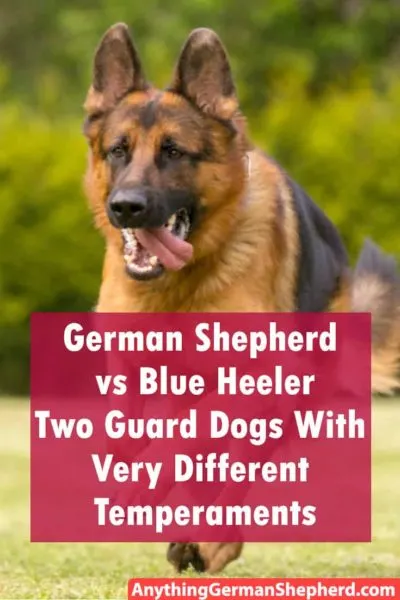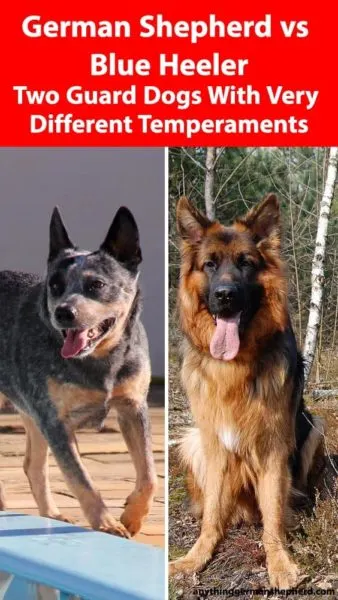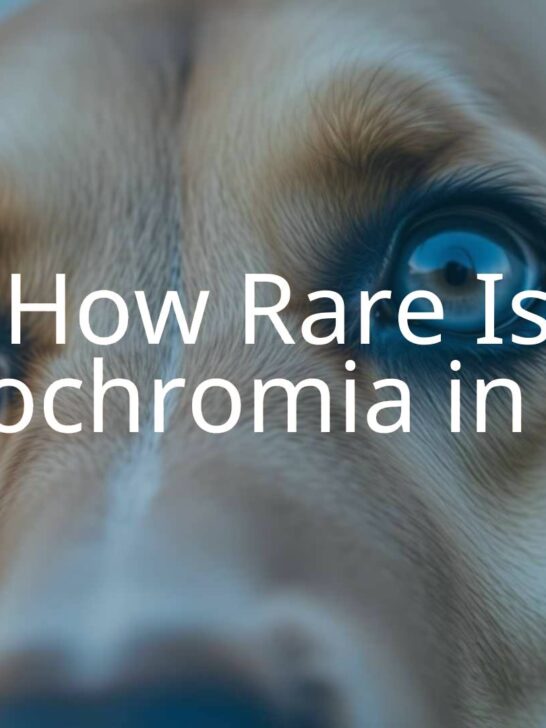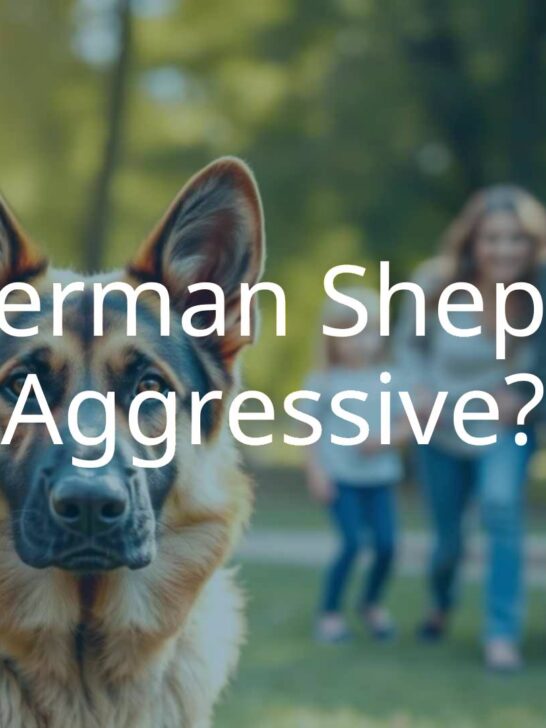German Shepherd vs Blue Heeler: Two Guard Dogs With Very Different Temperaments
Choosing a new companion canine can be a complicated decision. With at least 195 registered purebred dogs and countless mixed and hybrid dog breeds to choose from, how will you ever decide?
Take the German Shepherd vs Blue Heeler, for example. These dogs have some important similarities and also some important differences. But there is no way to say that one dog breed is “better” than the other.
There is only the process you must go through to determine which of these two dog breeds is a better fit for your lifestyle, preferences, and what you have to offer a pet dog.
In this article, you will receive in-depth knowledge about both the iconic German Shepherd, or GSD, and the Blue Heeler, also known as the ACD, or Australian Cattle Dog.
By the time you finish reading this article, you will have the information to know which of these two great dog breeds is the right fit for you.
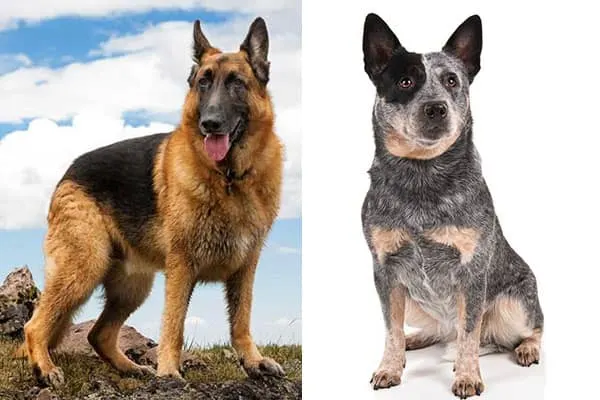
German Shepherd vs Blue Heeler: A Brief History of Each Breed
One of the best ways to begin your decision-making process is to learn a bit more about the history of any dog breed you are considering bringing into your family.
Learning about a dog breed’s history will tell you a lot more about that dog breed’s instincts, drives, needs, and strengths.
German Shepherd dog breed history
According to the American Kennel Club (AKC), the German Shepherd dog is called Deutsche Schäferhund in its home country of Germany.
These dogs have been bred deliberately to create an excellent herding and guarding dog. A man named Captain Max von Stephanitz is chiefly responsible for the origination and development of the breed as well as for most of the early promotion.
Thanks to the good Captain’s efforts, the German Shepherd is now the second most popular purebred dog breed in the United States and is also wildly popular in many other places around the world.
German Shepherds aren’t thought of as primarily herding and livestock dogs anymore, however. This is because modern practices have lessened the need for livestock guarding dogs.
So today, the GSD is much more famous for this dog’s role in guarding and serving people. GSDs are famous as search and rescue dogs, military and police dogs, service and therapy dogs, and canine athletes extraordinary.
Blue Heeler dog breed history
The Blue Heeler, or Australian Cattle Dog, actually owes as much of its history and lineage to Britain as it does to the country from which it takes its breed name.
The Blue Heeler breed is the result of crossbreeding a British dog breed called Smithfields with the wild Australian dingo dog. Along the way, the Dalmatian dog breed line was added in along with the Black and Tan Kelpie.
This, as the American Kennel Club (AKC), explains, created the compact, powerful and tireless dog breed known today as the Australian Cattle Dog or ACD.
German Shepherd vs Blue Heeler: Personality and Temperament
Even though both the German Shepherd and the Blue Heeler were bred and developed to do similar jobs, their personalities can be quite different.
In this section, we take an up-close and personal look at the personality and temperament of the German Shepherd vs Blue Heeler dog.
German Shepherd personality and temperament
The German Shepherd has two personalities: the personality this dog shows to “their” people and the personality this dog shows to strangers.
With their human family, the GSD is affectionate, playful, doting, and incredibly loyal. With strangers, whether animals or people, the GSD is reliably aloof and guarded.
A well-socialized German Shepherd dog will know how to cope with the presence of visitors to the home, but may never be particularly friendly towards them.
Because the German Shepherd dog is a true working dog breed, they do best with regular activity or a specific job to do.
Blue Heeler personality and temperament
The Blue Heeler is incredibly intelligent and driven with an undeniably independent streak. These dogs have been bred to work independently and often at great distances from their human work partners.
For this reason, the Blue Heeler tends to have a stubborn streak that only intense activity along with consistent training can ease.
The Blue Heeler is a true working dog breed and needs to have a job to do to be a healthy, happy companion canine.
German Shepherd vs Blue Heeler: Size, Height, and Weight
One of the areas where the German Shepherd vs Blue Heeler differences become most apparent is in size.
Because of this, if you live in a very small space or own a small vehicle, you may want to reconsider choosing a large dog like the GSD. However, if you have a large outdoor space this may not be a problem.
Let’s take a closer look now at the difference in size, height, and weight between these two dog breeds.
German Shepherd size, height, and weight
An adult German Shepherd may stand anywhere from 22 to 26 inches tall (paw pad to shoulder). Weight-wise, a GSD can weigh anywhere from 50 to 90 pounds.
In most cases, adult female German Shepherds will be shorter and weigh less than adult male GSDs.
Blue Heeler size, height, and weight
The Blue Heeler is a true medium size dog breed, standing between 17 and 20 inches (paw pad to shoulder) and weighing between 35 and 50 pounds.
German Shepherd vs Blue Heeler: Training and Exercise Needs
The area where the German Shepherd and the Blue Heeler may be the most similar is in their shared need for intense physical activity and exercise.
Similarly, both dog breeds need early and ongoing training using positive reinforcement methods to be happy and healthy in the role of a companion canine.
German Shepherd training and exercise needs
The German Shepherd does need a lot of daily exercise and activity, in keeping with this dog’s role as a working dog breed.
These dogs are incredible athletes and enrolling in a canine agility program is a great way to enrich your GSD’s daily life.
German Shepherd dogs need early and ongoing training and socialization because of their strong guarding and herding instincts. They need to learn how to deal with strange people and animals in socially appropriate ways.
Luckily, the GSD has an intensely strong people focus and drive to please “their” people, which can make training a lot easier.
This short YouTube video gives you an inside look at the famous GSD’s intense focus and drives to work, protect, and serve.
Blue Heeler training and exercise needs
The Blue Heeler has been built and bred to be all-go, no-stop, on the job both day and night. This makes it unwise to bring a Blue Heeler into your life unless you can provide either intense physical activity or a bona fide job for your dog to do.
Blue Heelers have a known stubborn streak and tend to have less of a natural drive to please people than many other companion canines. This is because of their need to work effectively at long distances while herding and protecting livestock.
For this reason, you should begin training and socialization as early as possible and ideally in puppyhood. Only positive training methods will work well with Blue Heelers, which are among the smartest of all dog breeds.
German Shepherd vs Blue Heeler: Health and Longevity
Many purebred dog breeds today are developing health conditions linked to their genes. This is because too many purebred dog breeding programs are focusing on breeding for looks rather than for health.
This is also why the research you do into a dog’s health and longevity is arguably the most important research for determining which dog breed to invite into your life.
As you are about to see, comparing the health and longevity of the German Shepherd vs Blue Heeler showcases just how different two dog breeds can be.
The best place to go to learn about genetic health issues of a purebred dog breed is the Orthopedic Foundation for Animals’ Canine Health Information Center (OFA-CHIC) database.
German Shepherd health and longevity
According to the OFA-CHIC database, the German Shepherd dog has the following known genetic health issues.
What does this mean for you? It means that you should always work with a reputable, responsible dog breeder that pre-tests adult dogs before breeding them.
It also means you may want to consider doing genetic testing if you plan to rescue a GSD puppy or adult dog for which you have no other background information.
These are the genetic health issues the GSD tends to suffer from and should be tested for:
- Hip and elbow dysplasia.
- Eye issues.
- Cardiac issues.
- Temperament issues.
- Autoimmune thyroiditis.
- Degenerative myelopathy.
Blue Heeler health and longevity
According to the OFA-CHIC database, the Australian Cattle Dog or Blue Heeler also suffers from several known genetically transmitted health conditions that can be tested before a pair of adult dogs are bred.
Be aware that any responsible breeder will happily show you these testing results and often will even volunteer the results without you having to ask.
You should also expect and receive an initial guarantee of health if you choose to bring home a purebred Blue Heeler puppy. This initial health guarantee typically is for 12 to 24 months and will outline exactly what it does and does not cover.
Here are the genetic health conditions Blue Heelers are known to experience that should be tested for:
- Hip and elbow dysplasia.
- Patellar luxation.
- Eye issues, including Progressive Retinal Atrophy (PRA).
- Congenital deafness.
- Cardiac issues.
- PennHip (dysplasia).
Even one of these health issues can make a significant dent in your budget and your dog’s quality of life, so it is worth taking the time to pick the healthiest possible puppy or rescue dog!
German Shepherd vs Blue Heeler: Which Dog Is Better for Kids?
When you are comparing two dog breeds to determine which would be the better choice for a family with children, it is important to consider each dog’s temperament and personality as well as their size and strength.
As well, the level and type of training and socialization your dog receives can greatly impact whether they grow up to become a great family dog or not.
German Shepherds are known to be gentle and intensely protective of children. These dogs seem to know their strength and can learn to be very tender with the smallest family members.
The Australian Cattle Dog gets its breed nickname of “blue heeler” from two places: coat color and herding style.
When it comes to adding a Blue Heeler into a household where there are young children, it is the latter that may become problematic.
This is because Blue Heelers typically herd livestock by nipping at their heels. Children may find this scary or painful and may react in ways that do not foster the canine-human bond.
However, some people have both young children and Blue Heelers in the same household and it works out well. It just depends on how much training and socialization you are willing and able to do.
German Shepherd vs Blue Heeler: Which Dog Breed Is Right for You?
Which dog breed is the right choice for you when it comes to comparing the German Shepherd vs Blue Heeler?
People who love either breed swear by them and many owners wouldn’t consider owning a different dog breed. So the only question now is, which dog best fits your lifestyle, availability, and home space?
Recommended reading














